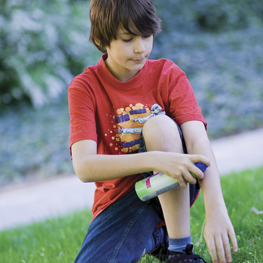
When thinking of summer, most of us picture sundrenched panoramas and enjoying time outside as a family swimming at the lake, paddling in the back yard pool or running through the front yard sprinkler. We smile as we remember our childhood summers filled with sunshine. Then suddenly our smiles fade away as we remember the dangers of sun and fear that someone in our family might develop skin cancer in their lifetime. So we slather on the sunscreen, avoid as much direct sunshine as we can manage and keep our skin as pale as possible all year round to keep our families safe. Except that now they’re telling us we’re low in Vitamin D (aka the sunshine vitamin) and that low levels of Vitamin D are linked with higher rates of cancer. Furthermore, some of the chemicals in conventional sunscreens are being linked with causing cancer. So what should we do?
We should apply the age-old adage of ‘everything in moderation.’ The biggest immediate indicator of high levels of sun damage is sunburn. So while enjoying the sunshine and the great outdoors, take precautions to avoid burning the skin.
Most of us have heard these precautions time and again, but they do warrant repeating:
Minimize time spent out in the sun, particularly between 11am and 3pm, when the sun’s intensity is strongest. As this is conveniently timed with lunchtime, enjoy a picnic in the shade and maybe even go for an afternoon siesta in a shaded area. If your kids are past the napping stage, build forts outside and hide in them, out of the sun.
Wear protective clothing such as sunhats, long sleeved, lightweight shirts, long skirts or light pants. Carry a sarong with you so you can create your own shade protection on the go.
Use sunscreen when out for long periods of time (ideally one that uses zinc oxide as its base). Zinc oxide creates a physical barrier instead of a chemical barrier between your skin and the sun. It is safe to be used on the whole family, including infants. There have been many advances in these sunscreens in recent years and they now come in many different formats: sprays, creams, lotions and powders. If you do get caught without a natural sunscreen and need to use a conventional sunscreen, make sure that you reapply it regularly. Research suggests that the chemicals in conventional sunscreen are most harmful when we apply it, let it somewhat wear off and then go back into the sun. How often you need sunscreen will largely depend on your skin, how much moisture (sweat, water, etc.) it’s exposed to and the amount of time you’re in the sun. There is conflicting evidence over using sunscreen daily, so you need to decide what makes more sense for you and your family.
Treat sunburns right away. Even if you only get a mild burn, apply soothing and healing salves made from aloe vera, rose oil and calendula. This will help rehydrate the skin and promote healing. Many after-sun lotions also contain antioxidants such as green tea that will help undo some of the damage done to the skin.
Stay hydrated! Aside from skin damage, dehydration is a major risk from being in the sun too long. This is easily avoided by making sure your family consumes plenty of fresh water, juicy fruits, such as watermelon and cantaloupe, or natural popsicles.
Here is a great recipe for popsicles from my friends at The Naturopathic Kitchen:
1 can organic full fat coconut milk
1 cup strawberries, fresh or frozen
2 Tbsp. raw honey
2 Tbsp. lemon juice
A few pinches of Celtic sea salt
Combine all ingredients in a blender. Blend until smooth. Pour into popsicle moulds and insert popsicle sticks. Put in freezer for 6 to 8 hours or overnight for best results. Enjoy on a warm, sunny day!
Like most things in life, the sun is not all good or all bad. A healthy respect for its power and effect on us is wise, as is enjoying a moment of warmth from the sun on our skin. So enjoy in moderation!
Dr. Stephanie Andrews, ND, is a licensed naturopathic doctor with an active family practice in Calgary. She provides holistic and natural treatments, through individualized care, that focus on prevention.
Calgary’s Child Magazine © 2024 Calgary’s Child